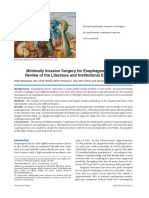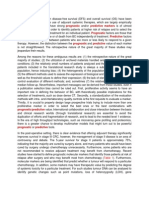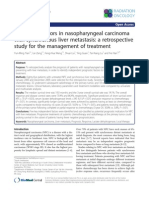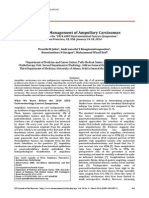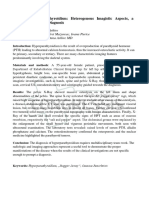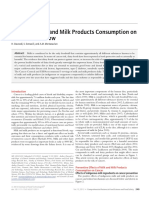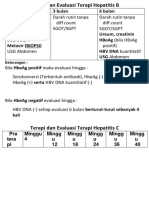Professional Documents
Culture Documents
The Comparison of Surgery and Chemo-Radio Therapy in Locally Recurrent Colorectal Cancer
Copyright
Available Formats
Share this document
Did you find this document useful?
Is this content inappropriate?
Report this DocumentCopyright:
Available Formats
The Comparison of Surgery and Chemo-Radio Therapy in Locally Recurrent Colorectal Cancer
Copyright:
Available Formats
Volume 7, Issue 11, November – 2022 International Journal of Innovative Science and Research Technology
ISSN No:-2456-2165
The Comparison of Surgery and Chemo-Radio
Therapy in Locally Recurrent Colorectal Cancer
Dr. Muhammad Israr Khan Dr. Shumaila Ghazan
Consultant Surgeon, Department of General Surgery, Surgical Registrar DHQ Hospital Charsadda,
Hayatabad Medical Complex, Peshawar, Pakistan Pakistan
Dr. Maryam Munir (Corresponding Author) Dr. Muhib Ullah
Medical Officer, District Headquarter Hospital Specialist Registrar, Surgical “A” Ward,
Landikotal, Pakistan Hayatabad Medical Complex, Peshawar Pakistan
Abstract:- Introduction: Globally, over 2 million I. INTRODUCTION
colorectal cancer cases were diagnosed. It is the second
most common cause of cancer fatalities, causing 1 million Globally, over 2 million colorectal cancer cases were
deaths annually. The current study aimed to compare diagnosed. It is the second most common cause of cancer
surgery and chemoradiotherapy treatment outcomes in fatalities, causing 1 million deaths annually. However, there are
colorectal cancer recurrence. Method: The current study good screening approaches that potentially minimize illness
was conducted using a randomized clinical trial design. fatalities globally [1].
The study was carried out at Hayatabad Medical Complex,
Peshawar. A total of 74 patients previously treated for Asia has more than half of all colorectal cancer cases and
colorectal cancer, were selected. The patients who showed fatalities. China has more than 500,000 new cases and 280,000
recurrence, based on radiology results, were selected for fatalities every year. Japan has the second-most colorectal
the current study. Survival from the commencement of cancer fatalities per year, 60 000. International Agency for
chemoradiotherapy/surgery to death from any cause or Research on Cancer (IARC) projects that colorectal cancer will
censoring at the final follow-up was defined as overall grow by 56% between 2020 and 2040, reaching more than 3
survival (OS). OS were calculated using the Kaplan–Meier million new cases annually [2]. The illness is expected to cause
technique and compared with the log-rank test. All 1.6 million deaths globally by 2040, a 69% rise. Most growth
analyses were conducted using SPSS v25 and Jamovi. is projected in high-Human Development Index (HDI) nations.
Result: A total of 21 patient included in the final analysis. IARC researchers found that many variables enhance or reduce
The mean age in the surgery group was quite higher than colorectal cancer risk. Most of these variables increase or
the chemoradiotherapy group (p = 0.31). The male to decrease the risk of other cancers [3].
female ratio in each group was 12/4, 8/3 respectively. The
timer size was quite higher than the chemoradiotherapy In 2020, alcohol caused 165,000 new instances of
group (p = 0.20). Two patients were died in the colorectal cancer or 8% of all cases. Alcohol intake raises the
chemoradiotherapy group while one patient was died in risk of six additional cancers, including liver and breast cancer
surgery group. The survival rate of the surgery was quite [4]. Smoking causes lung cancer [5], while HPV causes
good as compared to the chemoradiotherapy group. In the cervical cancer [6]. Both variables lead to colorectal cancer.
chemoradiotherapy group the patients survived up to 30 Obesity raises colorectal cancer risk. Obesity caused 85 000
months, however, the patient treats with surgery showed instances of colon cancer and 25 000 cases of rectal cancer in
the longest survival. Conclusion: The current study 2012, or 23% of all colorectal cancer cases. Obesity raises the
compared the surgery and Chemo-radio therapy in locally risk of seven additional cancers. Weight reduction, exercise,
recurrent colorectal cancer. Two patients in the and diets rich in fish, fruits, and vegetables reduce colorectal
chemoradiotherapy group and one in the surgery group cancer risk [7]. Screening raises the likelihood of discovering
was died. Compared to those who had chemoradiation, colorectal cancer at an earlier, more controllable stage [8].
surgical patients had a much higher chance of survival. In
the chemoradiotherapy group, patients lived up to 30 Colorectal cancer treatment is broadly divided into two
months; nevertheless, the surgical group had the longest categories: local and systematic. Local therapies address the
survival rate. tumor without impacting other organs [9]. Colorectal surgeries
are the most common way to remove the tumor and surround
Keywords:- Colorectal Cancer, Recurrence, healthy tissues to resect the affected area. In addition to surgical
Chemoradiotherapy, Surgery. resection, the other options include laparoscopic surgeries,
colostomy, and radiofrequency ablation. Drugs may also be
used to treat colorectal cancer; they can be administered orally
or straight into circulation. These are systemic therapies
because they may reach almost all cancer cells in the body.
Chemotherapy for Colorectal Cancer, Targeted Therapy for
Colorectal Cancer, and Immunotherapy for Colorectal Cancer
IJISRT22NOV436 www.ijisrt.com 827
Volume 7, Issue 11, November – 2022 International Journal of Innovative Science and Research Technology
ISSN No:-2456-2165
may be administered depending on the kind of colorectal C. Statistical analysis
cancer [10, 11]. Multiple therapy methods may be utilized Survival from the commencement of
concurrently or sequentially depending on the cancer stage and chemoradiotherapy/surgery to death from any cause or
other parameters. Typically, stages 0, I, II, and III are surgically censoring at the final follow-up was defined as overall survival
treatable. However, many patients with stage III colorectal (OS). OS were calculated using the Kaplan–Meier technique
cancer, and some with stage II, have chemotherapy after and compared with the log-rank test. All analyses were
surgery to boost the likelihood of curing the illness. Before or conducted using SPSS v25 and Jamovi.
after surgery, individuals with stages II and III rectal cancer
will also get radiation treatment and chemotherapy. In most
cases, stage IV cancer cannot be cured, but it is treated to
control its progression and symptoms [12, 13]. The current
study aimed to compare surgery and chemoradiotherapy
treatment outcomes in colorectal cancer recurrence.
II. METHOD
A. Study design and patients
The current study was conducted using a randomized
clinical trial design. The study was carried out at Hayatabad
Medical Complex, Peshawar. A total of 74 patients previously
treated for colorectal cancer, were selected. The patients who
showed recurrence, based on radiology results, were selected
for the current study. Moreover, the patients that were not
eligible (stage IV) and were not willing to participate were
excluded from the current study. The selected patients were
randomly assigned to surgery (n =16) and chemoradiotherapy
(n = 11) groups and prospectively followed for three years. The
detail can be seen in Figure 1.
B. Chemoradiotherapy regimens
All patients received external beam radiation (50 to 60
Gy) with concurrent chemotherapy such as 5-FU continuous Fig 1. The detail of the patient selection and follow-up
infusion (ci), or S-1, weekly 5-FU ci plus oxaliplatin, modified
FOLFOX6 (mFOLFOX). 5-FU ci regimen was a continuous III. RESULTS
infusion of 2500 mg/week mg/m2 of 5-FU (7 days), repeated
every week. S-1 was administered orally at the dose of 80 A total of 21 patient included in the final analysis. The
mg/m2/day. Weekly 5-FU ci plus oxaliplatin regimen consisted mean age in the surgery group was quite higher than the
of intravenous infusion of 50 mg/m2 of oxaliplatin (2 h) on day chemoradiotherapy group (p = 0.31). The male to female ratio
1 and continuous infusion of 2,500 mg/week 5-FU (7 days), in each group was 12/4, 8/3 respectively. The timer size was
repeated every week. The mFOLFOX regimen consisted of quite higher than the chemoradiotherapy group ( p = 0.20). Two
intravenous infusion of 85 mg/m2 of oxaliplatin (2 h), 200 patients were died in the chemoradiotherapy group while one
mg/m2 l-leucovorin (2 hours), and 400 mg/m2 bolus 5-FU on patient was died in surgery group. The detail can be seen in
day 1, followed by a continuous infusion of 2,400 mg/m2 of 5- Table 1. The survival rate of the surgery was quite good as
FU (46 h), repeated every 2 weeks. Chemotherapy started from compared to the chemoradiotherapy group. In the
the first day and was repeated to the last day of radiotherapy in chemoradiotherapy group the patients survived up to 30
all patients, and subsequent chemotherapy regimens were months, however, the patient treats with surgery showed the
determined by each physician’s discretion according to the longest survival as shown in Figure 2.
efficacy and toxicities of CRT. Six patients continued to
receive chemotherapy until disease progression after the
completion of radiation therapy.
IJISRT22NOV436 www.ijisrt.com 828
Volume 7, Issue 11, November – 2022 International Journal of Innovative Science and Research Technology
ISSN No:-2456-2165
Table 1. Patient characteristics and treatment outcome
Group
Surgery CRT P-value
Mean ± SD N (%) Mean ± SD N (%)
Age (years) 54 ± 14 49 ± 11 0.31
Gender Male 12 (60%) 8 (40)
0.89
Female 4 (57.1%) 3 (42.9)
Period of recurrence 32 ±8 29 ± 9 0.46
Tumor size 46.09 ± 5.28 42.81 ± 7.82 0.20
Patient Survived 15 (62.5) 9 (37.5)
status Death 0.33
1 (33.3) 2 (66.7)
Fig 1. Treatment of the surgery and CRT.
IV. DISCUSSION Reportedly, the combination of 5-FU radiotherapy (RT)
improves survival for locally unresectable rectal cancer over
The current study compared the surgery and Chemo-radio radiotherapy alone [17]. It has been observed that observed that
therapy in locally recurrent colorectal cancer. Two patients in Chemoradiotherapy (CRT) (continuous infusion of 5-FU+RT)
the chemoradiotherapy group and one in the surgery group was was more effective than radiotherapy alone in 30 patients with
died. Compared to those who had chemoradiation, surgical locally recurrent rectal cancer. In addition, it has been showed
patients had a much higher chance of survival. In the increase in the median OS of patients treated with CRT over
chemoradiotherapy group, patients lived up to 30 months; RT alone (median survival time 9.3 months). In addition, CRT
nevertheless, the surgical group had the longest survival rate. was successful in relieving pain, and 5-FU-based regimens
were found to be effective and safe. Compared to their findings
Regarding the treatment approach for local rectal cancer on CRT, our results demonstrated similar survival effects of
recurrence, there is no unanimity. Only 20-40% of patients with CRT. The median OS was not attained in our investigation, and
recurrent rectal cancer are suitable for curative resection (R0) survival in our group was superior to that of the CRT group in
resection, despite the fact that radical resection is the treatment Ito's trial. This disparity in effectiveness between the Ito
of choice with a high cure rate [14]. It has been observed that research and our present data may be attributable to variations
there was no significant difference in long-term survival in chemotherapy regimens and radiation treatment.
between R2 resection and non-surgical treatments for patients
who are ineligible [15]. Consequently, if R0 cannot be done, Since the introduction of oxaliplatin into clinical practice,
surgical resection is not anticipated to provide a greater colorectal cancer chemotherapy has achieved significant
advantage. Radiation therapy and systemic chemotherapy advances. Chemotherapy using oxaliplatin and 5-FU, such as
alone or in combination should be considered at this point in the FOLFOX regimen, is more successful and has become the
the treatment of patients [16]. In contrast, in the current study, standard treatment for colorectal cancer in its later stages [18,
the survival was quite good in surgery group compared to the 19]. In addition, preoperative CRT with an oxaliplatin-
chemoradiotherapy. containing regimen demonstrated a high success rate with
acceptable toxicity in patients with locally advanced rectal
cancer. Hu et al. evaluated CRT [FOLFOX4+three-
dimensional conformal radiation (3-DCRT)] and RT based on
IJISRT22NOV436 www.ijisrt.com 829
Volume 7, Issue 11, November – 2022 International Journal of Innovative Science and Research Technology
ISSN No:-2456-2165
prior research on CRT that included oxaliplatin-containing [11]. Hashiguchi, Y., et al., Japanese Society for Cancer of the
regimens for rectal cancer recurrence. The CRT group had a Colon and Rectum (JSCCR) guidelines 2019 for the
much better 2-year survival rate and a significantly greater treatment of colorectal cancer. International journal of
response rate (56% vs 40%) [20]. You et al. also evaluated the clinical oncology, 2020. 25(1): p. 1-42.
efficacy of concurrent CRT with oxaliplatin [12]. Piawah, S. and A.P. Venook, Targeted therapy for
(oxaliplatin+pelvic irradiation) in 96 patients with locally colorectal cancer metastases: A review of current
recurrent rectal cancer and reported a CR rate of 14% and a PR methods of molecularly targeted therapy and the use of
rate of 61%. (24). Cai et al. reported a CR rate of 5.6% after tumor biomarkers in the treatment of metastatic
CRT with capecitabine and irinotecan and intensity modulated colorectal cancer. Cancer, 2019. 125(23): p. 4139-4147.
radiation treatment (IMRT) (45 Gy), which was related with a [13]. Brouwer, N.P., et al., An overview of 25 years of
3-year survival rate of 36.5%; the 3-year local progression-free incidence, treatment and outcome of colorectal cancer
survival rate was 33.9% after a median follow-up of 31 months. patients. International journal of cancer, 2018. 143(11):
As for side effects, the incidence of grade 4 leukopenia was p. 2758-2766.
4.8%, grade 3 diarrhoea was 22.5%, and the toxicity was within [14]. Bhangu, A., et al., Comparison of long‐term survival
the allowable limit [21]. outcome of operative vs nonoperative management of
recurrent rectal cancer. Colorectal Disease, 2013. 15(2):
This study has several limitations. First, we only p. 156-163.
evaluated a small number of patients. Second, many of the [15]. Pacelli, F., et al., Locally recurrent rectal cancer:
patients were censored cases, which may have led to prognostic factors and long-term outcomes of
overestimation of the OS results. multimodal therapy. Annals of Surgical Oncology, 2010.
17(1): p. 152-162.
V. CONCLUSION [16]. Tanis, P.J., A. Doeksen, and J.J.B. van Lanschot,
Intentionally curative treatment of locally recurrent rectal
The current study compared the surgery and Chemo-radio cancer: a systematic review. Canadian journal of
therapy in locally recurrent colorectal cancer. Two patients in Surgery, 2013. 56(2): p. 135.
the chemoradiotherapy group and one in the surgery group was [17]. Moertel, C., et al., Combined 5-fluorouracil and
died. Compared to those who had chemoradiation, surgical supervoltage radiation therapy of locally unresectable
patients had a much higher chance of survival. In the gastrointestinal cancer. The Lancet, 1969. 294(7626): p.
chemoradiotherapy group, patients lived up to 30 months; 865-867.
nevertheless, the surgical group had the longest survival rate. [18]. de Gramont, A.d., et al., Leucovorin and fluorouracil
with or without oxaliplatin as first-line treatment in
REFERENCES advanced colorectal cancer. Journal of Clinical
Oncology, 2000. 18(16): p. 2938-2947.
[1]. Siegel, R.L., et al., Cancer statistics, 2022. CA: A Cancer [19]. Goldberg, R.M., et al., A randomized controlled trial of
Journal for Clinicians, 2022. 72(1): p. 7-33. fluorouracil plus leucovorin, irinotecan, and oxaliplatin
[2]. Yee, Y.K., et al., Epidemiology of colorectal cancer in combinations in patients with previously untreated
Asia. Journal of gastroenterology and hepatology, 2009. metastatic colorectal cancer. Journal of Clinical
24(12): p. 1810-1816. Oncology, 2004. 22(1): p. 23-30.
[3]. Onyoh, E.F., et al., The rise of colorectal cancer in Asia: [20]. Hu, J.-B., et al., Three-dimensional conformal
epidemiology, screening, and management. Current radiotherapy combined with FOLFOX4 chemotherapy
gastroenterology reports, 2019. 21(8): p. 1-10. for unresectable recurrent rectal cancer. World journal of
[4]. Cho, E., et al., Alcohol intake and colorectal cancer: a gastroenterology: WJG, 2006. 12(16): p. 2610.
pooled analysis of 8 cohort studies. Annals of internal [21]. Cai, G., et al., CAPIRI-IMRT: a phase II study of
medicine, 2004. 140(8): p. 603-613. concurrent capecitabine and irinotecan with intensity-
[5]. Liang, P.S., T.Y. Chen, and E. Giovannucci, Cigarette modulated radiation therapy for the treatment of
smoking and colorectal cancer incidence and mortality: recurrent rectal cancer. Radiation Oncology, 2015. 10(1):
Systematic review and meta‐analysis. International p. 1-6.
journal of cancer, 2009. 124(10): p. 2406-2415.
[6]. Ibragimova, M.K., M.M. Tsyganov, and N.V. Litviakov,
Human papillomavirus and colorectal cancer. Medical
Oncology, 2018. 35(11): p. 1-6.
[7]. Jochem, C. and M. Leitzmann, Obesity and colorectal
cancer. Obesity and Cancer, 2016: p. 17-41.
[8]. Montminy, E.M., et al., Screening for colorectal cancer.
Medical Clinics, 2020. 104(6): p. 1023-1036.
[9]. Biller, L.H. and D. Schrag, Diagnosis and treatment of
metastatic colorectal cancer: a review. Jama, 2021.
325(7): p. 669-685.
[10]. Modest, D., S. Pant, and A. Sartore-Bianchi, Treatment
sequencing in metastatic colorectal cancer. European
Journal of Cancer, 2019. 109: p. 70-83.
IJISRT22NOV436 www.ijisrt.com 830
You might also like
- Radiotherapy of Liver CancerFrom EverandRadiotherapy of Liver CancerJinsil SeongNo ratings yet
- A Comparative Study On The Treatment of Cervical Carcinoma by Radiotherapy Alone vs. Radiotherapy WiDocument13 pagesA Comparative Study On The Treatment of Cervical Carcinoma by Radiotherapy Alone vs. Radiotherapy WiIJRASETPublicationsNo ratings yet
- International Seminars in Surgical OncologyDocument8 pagesInternational Seminars in Surgical OncologyAhmad ShafiqNo ratings yet
- AsdasdDocument10 pagesAsdasdAdhi PratamaNo ratings yet
- The Optimal Neoadjuvant Treatment of Locally Advanced Esophageal CancerDocument11 pagesThe Optimal Neoadjuvant Treatment of Locally Advanced Esophageal CancerdjonesthoracicNo ratings yet
- 1 4918218693336367165 PDFDocument14 pages1 4918218693336367165 PDFjorgeaznarNo ratings yet
- Concurrent Radiotherapy and Weekly Paclitaxel For Locally Advanced Squmous Cell Carcinoma of Uterine Cervix-Treated Patients at Rural Centre in IndiaDocument5 pagesConcurrent Radiotherapy and Weekly Paclitaxel For Locally Advanced Squmous Cell Carcinoma of Uterine Cervix-Treated Patients at Rural Centre in IndiaIjsrnet EditorialNo ratings yet
- Surgery For Cervical Cancer Consensus & ControversiesDocument9 pagesSurgery For Cervical Cancer Consensus & ControversiesmilenahugueninNo ratings yet
- Referatneoadjuvan EnggrisDocument22 pagesReferatneoadjuvan EnggrisPonco RossoNo ratings yet
- CA ServiksDocument10 pagesCA ServiksAndi Farid ANo ratings yet
- Clinical StudyDocument7 pagesClinical StudyTit fuckerNo ratings yet
- Neoadjuvant chemoradiotherapy followed by surgery standard for esophageal cancerDocument14 pagesNeoadjuvant chemoradiotherapy followed by surgery standard for esophageal cancerkrsna2studyNo ratings yet
- Nihms 528278Document19 pagesNihms 528278Adrian HaningNo ratings yet
- Debiri 1Document12 pagesDebiri 1paquidermo85No ratings yet
- Minimally Invasive Surgery For Esophageal Cancer: Review of The Literature and Institutional ExperienceDocument8 pagesMinimally Invasive Surgery For Esophageal Cancer: Review of The Literature and Institutional ExperienceNurulArifahAmirNo ratings yet
- Pi Is 1879850016300947Document7 pagesPi Is 1879850016300947Daniela GordeaNo ratings yet
- Anaesthesia For Pancreatic SurgeryDocument11 pagesAnaesthesia For Pancreatic SurgeryDianita P Ñáñez VaronaNo ratings yet
- FLOT 3 QuimioterapiaDocument8 pagesFLOT 3 Quimioterapiaerica corral corralNo ratings yet
- 10 1016@j Jfma 2018 01 015Document10 pages10 1016@j Jfma 2018 01 015darpa22No ratings yet
- Clinical Impact of External Radiotherapy in Non-Metastatic Esophageal Cancer According To Histopathological SubtypeDocument12 pagesClinical Impact of External Radiotherapy in Non-Metastatic Esophageal Cancer According To Histopathological SubtypesilviailieNo ratings yet
- Prognostic Predictive Markers Prognostic Predictive Prognostic PredictiveDocument5 pagesPrognostic Predictive Markers Prognostic Predictive Prognostic Predictivepre_singh2136No ratings yet
- P1 Functional Outcomes and Health-Related QualityDocument11 pagesP1 Functional Outcomes and Health-Related Qualityernitaranterupang79No ratings yet
- 10 1016@j LPM 2019 02 025Document15 pages10 1016@j LPM 2019 02 025Paulina Sobarzo VegaNo ratings yet
- 004 Contents - 2023 - Surgical Oncology Clinics of North AmericaDocument4 pages004 Contents - 2023 - Surgical Oncology Clinics of North AmericaDr-Mohammad Ali-Fayiz Al TamimiNo ratings yet
- Vertebral HemangiomaDocument6 pagesVertebral HemangiomanotallowedNo ratings yet
- Standard surgical procedures and adjuvant therapies for colon cancerDocument46 pagesStandard surgical procedures and adjuvant therapies for colon cancerNadia Iriana DewiNo ratings yet
- EJGO2022054 Cervical CaDocument8 pagesEJGO2022054 Cervical CaRahmayantiYuliaNo ratings yet
- Neoadjuvant Chemoradiotherapy Followed by Surgery VersusDocument15 pagesNeoadjuvant Chemoradiotherapy Followed by Surgery VersusRaul Matute MartinNo ratings yet
- Ags3 2 129Document8 pagesAgs3 2 129Radu MiricaNo ratings yet
- Bristow 2002Document12 pagesBristow 2002Lưu Chính HữuNo ratings yet
- Prognostic Factors in Nasopharyngeal Carcinoma With Synchronous Liver Metastasis: A Retrospective Study For The Management of TreatmentDocument7 pagesPrognostic Factors in Nasopharyngeal Carcinoma With Synchronous Liver Metastasis: A Retrospective Study For The Management of TreatmentChairul Nurdin AzaliNo ratings yet
- Impact of Neoadjuvant Chemotherapy in Breast Cancer Patients A Single Center StudyDocument6 pagesImpact of Neoadjuvant Chemotherapy in Breast Cancer Patients A Single Center StudyInternational Journal of Innovative Science and Research TechnologyNo ratings yet
- Pathological complete response in recurrent colon cancer following neoadjuvant radiotherapy and intraperitoneal chemotherapyDocument4 pagesPathological complete response in recurrent colon cancer following neoadjuvant radiotherapy and intraperitoneal chemotherapyAlice AugustinNo ratings yet
- Nej Mo A 1414882Document9 pagesNej Mo A 1414882Corina Hagiu-RaduNo ratings yet
- Updates in Management of Ampullary Carcinomas: Highlight ArticleDocument4 pagesUpdates in Management of Ampullary Carcinomas: Highlight Articlecorinna291No ratings yet
- Update On Radiotherapy in Gynaecological Malignancies: ReviewDocument8 pagesUpdate On Radiotherapy in Gynaecological Malignancies: ReviewDesrha TangdiseruNo ratings yet
- 1019 5298 1 PBDocument11 pages1019 5298 1 PBm907062008No ratings yet
- Gog 141Document5 pagesGog 141Drsaumyta MishraNo ratings yet
- Kuipersetal CRC NRDP2015Document26 pagesKuipersetal CRC NRDP2015Robert ChristevenNo ratings yet
- Huang Et AlDocument7 pagesHuang Et AlDrsaumyta MishraNo ratings yet
- Male Breast Cancer: An Institutional ExperienceDocument5 pagesMale Breast Cancer: An Institutional ExperienceIJAR JOURNALNo ratings yet
- A Randomized Trial of Laparoscopic Versus Open Surgery For Rectal CancerDocument9 pagesA Randomized Trial of Laparoscopic Versus Open Surgery For Rectal CancerFarizka Dwinda HNo ratings yet
- MedicineDocument5 pagesMedicinepriyanka hermawanNo ratings yet
- The Evolving Role of Hypofractionated Radiotherapy in Older Adults With Gastrointestinal CancersDocument9 pagesThe Evolving Role of Hypofractionated Radiotherapy in Older Adults With Gastrointestinal CancersRaul Matute MartinNo ratings yet
- QUAD. 0 7 21 RegimenDocument6 pagesQUAD. 0 7 21 RegimenEskadmas BelayNo ratings yet
- Emerging 1Document7 pagesEmerging 1lotiyashubhamNo ratings yet
- Allen2021 Article ChemotherapyVersusChemotherapyDocument8 pagesAllen2021 Article ChemotherapyVersusChemotherapyXavier QuinteroNo ratings yet
- Minimally Invasive Versus Abdominal Radical HysterectomyDocument10 pagesMinimally Invasive Versus Abdominal Radical HysterectomyClinton Franda Markus SitanggangNo ratings yet
- Q 3 WedefDocument6 pagesQ 3 Wedefsupaidi97No ratings yet
- Kuipers 2015Document25 pagesKuipers 2015Fahmi RizalNo ratings yet
- 10 14338 - Ijpt-22-00021 1Document12 pages10 14338 - Ijpt-22-00021 1Raul Matute MartinNo ratings yet
- Axtner Et Al. - 2016 - Health Services Research of Integrative Oncology in Palliative Care of Patients With Advanced Pancreatic CancerDocument10 pagesAxtner Et Al. - 2016 - Health Services Research of Integrative Oncology in Palliative Care of Patients With Advanced Pancreatic CancerMaría Reynel TarazonaNo ratings yet
- AJHO May17 2Document8 pagesAJHO May17 2Meiyanti MeiyantiNo ratings yet
- Annals Case Reports PDF Final Final.25.05.l22.Document13 pagesAnnals Case Reports PDF Final Final.25.05.l22.rossbar13No ratings yet
- 2021 Consolidation Theraphy in Esophageal CancerDocument6 pages2021 Consolidation Theraphy in Esophageal CancerykommNo ratings yet
- Aoun 2015Document10 pagesAoun 2015skribekbenjaminNo ratings yet
- Surgical and Chemotherapeutic Cytoreduction For Advanced Primary and Recurrent Ovarian Cancer, The Washington Cancer Institute ApproachDocument21 pagesSurgical and Chemotherapeutic Cytoreduction For Advanced Primary and Recurrent Ovarian Cancer, The Washington Cancer Institute ApproachTJ LapuzNo ratings yet
- Ijbsv 12 P 1022Document10 pagesIjbsv 12 P 1022Nelson William UsnayoNo ratings yet
- Biomedicines 11 00890Document19 pagesBiomedicines 11 00890김현수No ratings yet
- Ead and Eck Ancer: RADPLAT: An Alternative To Surgery?Document12 pagesEad and Eck Ancer: RADPLAT: An Alternative To Surgery?Manikanta Sai KumarNo ratings yet
- Parastomal Hernia: A Case Report, Repaired by Modified Laparascopic Sugarbaker TechniqueDocument2 pagesParastomal Hernia: A Case Report, Repaired by Modified Laparascopic Sugarbaker TechniqueInternational Journal of Innovative Science and Research TechnologyNo ratings yet
- Smart Health Care SystemDocument8 pagesSmart Health Care SystemInternational Journal of Innovative Science and Research TechnologyNo ratings yet
- Visual Water: An Integration of App and Web to Understand Chemical ElementsDocument5 pagesVisual Water: An Integration of App and Web to Understand Chemical ElementsInternational Journal of Innovative Science and Research TechnologyNo ratings yet
- Air Quality Index Prediction using Bi-LSTMDocument8 pagesAir Quality Index Prediction using Bi-LSTMInternational Journal of Innovative Science and Research TechnologyNo ratings yet
- Smart Cities: Boosting Economic Growth through Innovation and EfficiencyDocument19 pagesSmart Cities: Boosting Economic Growth through Innovation and EfficiencyInternational Journal of Innovative Science and Research TechnologyNo ratings yet
- Parkinson’s Detection Using Voice Features and Spiral DrawingsDocument5 pagesParkinson’s Detection Using Voice Features and Spiral DrawingsInternational Journal of Innovative Science and Research TechnologyNo ratings yet
- Predict the Heart Attack Possibilities Using Machine LearningDocument2 pagesPredict the Heart Attack Possibilities Using Machine LearningInternational Journal of Innovative Science and Research TechnologyNo ratings yet
- Impact of Silver Nanoparticles Infused in Blood in a Stenosed Artery under the Effect of Magnetic Field Imp. of Silver Nano. Inf. in Blood in a Sten. Art. Under the Eff. of Mag. FieldDocument6 pagesImpact of Silver Nanoparticles Infused in Blood in a Stenosed Artery under the Effect of Magnetic Field Imp. of Silver Nano. Inf. in Blood in a Sten. Art. Under the Eff. of Mag. FieldInternational Journal of Innovative Science and Research TechnologyNo ratings yet
- An Analysis on Mental Health Issues among IndividualsDocument6 pagesAn Analysis on Mental Health Issues among IndividualsInternational Journal of Innovative Science and Research TechnologyNo ratings yet
- Compact and Wearable Ventilator System for Enhanced Patient CareDocument4 pagesCompact and Wearable Ventilator System for Enhanced Patient CareInternational Journal of Innovative Science and Research TechnologyNo ratings yet
- Implications of Adnexal Invasions in Primary Extramammary Paget’s Disease: A Systematic ReviewDocument6 pagesImplications of Adnexal Invasions in Primary Extramammary Paget’s Disease: A Systematic ReviewInternational Journal of Innovative Science and Research TechnologyNo ratings yet
- Terracing as an Old-Style Scheme of Soil Water Preservation in Djingliya-Mandara Mountains- CameroonDocument14 pagesTerracing as an Old-Style Scheme of Soil Water Preservation in Djingliya-Mandara Mountains- CameroonInternational Journal of Innovative Science and Research TechnologyNo ratings yet
- Exploring the Molecular Docking Interactions between the Polyherbal Formulation Ibadhychooranam and Human Aldose Reductase Enzyme as a Novel Approach for Investigating its Potential Efficacy in Management of CataractDocument7 pagesExploring the Molecular Docking Interactions between the Polyherbal Formulation Ibadhychooranam and Human Aldose Reductase Enzyme as a Novel Approach for Investigating its Potential Efficacy in Management of CataractInternational Journal of Innovative Science and Research TechnologyNo ratings yet
- Insights into Nipah Virus: A Review of Epidemiology, Pathogenesis, and Therapeutic AdvancesDocument8 pagesInsights into Nipah Virus: A Review of Epidemiology, Pathogenesis, and Therapeutic AdvancesInternational Journal of Innovative Science and Research TechnologyNo ratings yet
- Harnessing Open Innovation for Translating Global Languages into Indian LanuagesDocument7 pagesHarnessing Open Innovation for Translating Global Languages into Indian LanuagesInternational Journal of Innovative Science and Research TechnologyNo ratings yet
- The Relationship between Teacher Reflective Practice and Students Engagement in the Public Elementary SchoolDocument31 pagesThe Relationship between Teacher Reflective Practice and Students Engagement in the Public Elementary SchoolInternational Journal of Innovative Science and Research TechnologyNo ratings yet
- Investigating Factors Influencing Employee Absenteeism: A Case Study of Secondary Schools in MuscatDocument16 pagesInvestigating Factors Influencing Employee Absenteeism: A Case Study of Secondary Schools in MuscatInternational Journal of Innovative Science and Research TechnologyNo ratings yet
- Dense Wavelength Division Multiplexing (DWDM) in IT Networks: A Leap Beyond Synchronous Digital Hierarchy (SDH)Document2 pagesDense Wavelength Division Multiplexing (DWDM) in IT Networks: A Leap Beyond Synchronous Digital Hierarchy (SDH)International Journal of Innovative Science and Research TechnologyNo ratings yet
- Diabetic Retinopathy Stage Detection Using CNN and Inception V3Document9 pagesDiabetic Retinopathy Stage Detection Using CNN and Inception V3International Journal of Innovative Science and Research TechnologyNo ratings yet
- Advancing Healthcare Predictions: Harnessing Machine Learning for Accurate Health Index PrognosisDocument8 pagesAdvancing Healthcare Predictions: Harnessing Machine Learning for Accurate Health Index PrognosisInternational Journal of Innovative Science and Research TechnologyNo ratings yet
- Auto Encoder Driven Hybrid Pipelines for Image Deblurring using NAFNETDocument6 pagesAuto Encoder Driven Hybrid Pipelines for Image Deblurring using NAFNETInternational Journal of Innovative Science and Research TechnologyNo ratings yet
- Formulation and Evaluation of Poly Herbal Body ScrubDocument6 pagesFormulation and Evaluation of Poly Herbal Body ScrubInternational Journal of Innovative Science and Research TechnologyNo ratings yet
- The Utilization of Date Palm (Phoenix dactylifera) Leaf Fiber as a Main Component in Making an Improvised Water FilterDocument11 pagesThe Utilization of Date Palm (Phoenix dactylifera) Leaf Fiber as a Main Component in Making an Improvised Water FilterInternational Journal of Innovative Science and Research TechnologyNo ratings yet
- The Making of Object Recognition Eyeglasses for the Visually Impaired using Image AIDocument6 pagesThe Making of Object Recognition Eyeglasses for the Visually Impaired using Image AIInternational Journal of Innovative Science and Research TechnologyNo ratings yet
- The Impact of Digital Marketing Dimensions on Customer SatisfactionDocument6 pagesThe Impact of Digital Marketing Dimensions on Customer SatisfactionInternational Journal of Innovative Science and Research TechnologyNo ratings yet
- Electro-Optics Properties of Intact Cocoa Beans based on Near Infrared TechnologyDocument7 pagesElectro-Optics Properties of Intact Cocoa Beans based on Near Infrared TechnologyInternational Journal of Innovative Science and Research TechnologyNo ratings yet
- A Survey of the Plastic Waste used in Paving BlocksDocument4 pagesA Survey of the Plastic Waste used in Paving BlocksInternational Journal of Innovative Science and Research TechnologyNo ratings yet
- Cyberbullying: Legal and Ethical Implications, Challenges and Opportunities for Policy DevelopmentDocument7 pagesCyberbullying: Legal and Ethical Implications, Challenges and Opportunities for Policy DevelopmentInternational Journal of Innovative Science and Research TechnologyNo ratings yet
- Comparatively Design and Analyze Elevated Rectangular Water Reservoir with and without Bracing for Different Stagging HeightDocument4 pagesComparatively Design and Analyze Elevated Rectangular Water Reservoir with and without Bracing for Different Stagging HeightInternational Journal of Innovative Science and Research TechnologyNo ratings yet
- Design, Development and Evaluation of Methi-Shikakai Herbal ShampooDocument8 pagesDesign, Development and Evaluation of Methi-Shikakai Herbal ShampooInternational Journal of Innovative Science and Research Technology100% (3)
- Barium Enema: DR SK MD Asif Iquebal Junior Resident Medical College &kolkataDocument33 pagesBarium Enema: DR SK MD Asif Iquebal Junior Resident Medical College &kolkataSK MOMTAZUL KARIMNo ratings yet
- Cancer in KurdistanDocument18 pagesCancer in KurdistanJwan JawzaliNo ratings yet
- ConclusionDocument2 pagesConclusionIniche Tinta TandirerungNo ratings yet
- Science BiologyDocument76 pagesScience BiologynaninanyeshNo ratings yet
- Colon Cancer Pathophysiology PDFDocument2 pagesColon Cancer Pathophysiology PDFMaggieNo ratings yet
- Medicinal Plants Against CancerDocument58 pagesMedicinal Plants Against CancerMiguelArceMonroyNo ratings yet
- Anasurgery MockboardDocument12 pagesAnasurgery MockboardVince CabahugNo ratings yet
- Dietetics Module: Therapeutic Diets and Chronic Disease ManagementDocument24 pagesDietetics Module: Therapeutic Diets and Chronic Disease ManagementSara MagedNo ratings yet
- Epidemiology, Risk Factors and Treatment of Colorectal CarcinomaDocument19 pagesEpidemiology, Risk Factors and Treatment of Colorectal CarcinomaTaylorNo ratings yet
- Bhatti NotesDocument100 pagesBhatti NotesSergio Chang100% (2)
- Guideline on screening key NCDsDocument36 pagesGuideline on screening key NCDslilydariniNo ratings yet
- American Board of Surgery In-Service Training Exam (Absite) : Basic Science 101Document58 pagesAmerican Board of Surgery In-Service Training Exam (Absite) : Basic Science 1013011983caiviNo ratings yet
- Past QuestionsDocument116 pagesPast QuestionsYhr YhNo ratings yet
- Major Case Study NDDocument10 pagesMajor Case Study NDapi-313165458No ratings yet
- Management of Patients With Intestinal and Rectal DisordersDocument33 pagesManagement of Patients With Intestinal and Rectal DisordersDoneva Lyn MedinaNo ratings yet
- The Position of The Academy of Nutrition and Dietetics - Health Implications of Dietary FiberDocument5 pagesThe Position of The Academy of Nutrition and Dietetics - Health Implications of Dietary Fiberapi-532484980No ratings yet
- 2018 AM Educational BookDocument1,067 pages2018 AM Educational BookCarlosNo ratings yet
- PosterDocument45 pagesPosterRoxana Alexandra BogosNo ratings yet
- Mark Romero - Going VeganDocument171 pagesMark Romero - Going Veganacademo misirNo ratings yet
- Effects of Milk and Milk Products Consumption OnCancerDocument16 pagesEffects of Milk and Milk Products Consumption OnCancerCHRISTIAN BENJAMIN CHANG CORNEJONo ratings yet
- Pra Terapi 3 Bulan 6 Bulan Hbsag Hbeag HBV Dna Kuantitatif Metavir (Biopsi) Ureum, Creatinin Hbeag (Bila Hbsag HBV Dna Kuantitatif Usg AbdomenDocument24 pagesPra Terapi 3 Bulan 6 Bulan Hbsag Hbeag HBV Dna Kuantitatif Metavir (Biopsi) Ureum, Creatinin Hbeag (Bila Hbsag HBV Dna Kuantitatif Usg AbdomenAhmad JazmiNo ratings yet
- Cancer Screening and PreventionDocument31 pagesCancer Screening and PreventionShadin SNo ratings yet
- Problem 5 Git Aldi FDocument158 pagesProblem 5 Git Aldi Faldi firdausNo ratings yet
- Case Study Colorectal CancerDocument23 pagesCase Study Colorectal CancerLeogalvez BedanoNo ratings yet
- Kronmed: Congresul Național Pentru Studenți Și Tineri MediciDocument87 pagesKronmed: Congresul Național Pentru Studenți Și Tineri MediciIubiNo ratings yet
- 4 Series CPTDocument13 pages4 Series CPTPraviiNo ratings yet
- WEEK 4 - MEDSURG - Cellular AberrationDocument10 pagesWEEK 4 - MEDSURG - Cellular AberrationLeslie CruzNo ratings yet
- Practical 7 Dysplasia Carcinogen Es IsDocument19 pagesPractical 7 Dysplasia Carcinogen Es IsRujha Haniena Ahmad RidzuanNo ratings yet
- RETRACTED ARTICLE: Immunotherapy of Metastatic Colorectal Cancer With Vitamin D-Binding Protein-Derived Macrophage-Activating Factor, GcMAFDocument10 pagesRETRACTED ARTICLE: Immunotherapy of Metastatic Colorectal Cancer With Vitamin D-Binding Protein-Derived Macrophage-Activating Factor, GcMAFNagalaseNo ratings yet
- The Age of Magical Overthinking: Notes on Modern IrrationalityFrom EverandThe Age of Magical Overthinking: Notes on Modern IrrationalityRating: 4 out of 5 stars4/5 (17)
- Why We Die: The New Science of Aging and the Quest for ImmortalityFrom EverandWhy We Die: The New Science of Aging and the Quest for ImmortalityRating: 4 out of 5 stars4/5 (3)
- Summary: The Psychology of Money: Timeless Lessons on Wealth, Greed, and Happiness by Morgan Housel: Key Takeaways, Summary & Analysis IncludedFrom EverandSummary: The Psychology of Money: Timeless Lessons on Wealth, Greed, and Happiness by Morgan Housel: Key Takeaways, Summary & Analysis IncludedRating: 5 out of 5 stars5/5 (78)
- The Obesity Code: Unlocking the Secrets of Weight LossFrom EverandThe Obesity Code: Unlocking the Secrets of Weight LossRating: 5 out of 5 stars5/5 (4)
- By the Time You Read This: The Space between Cheslie's Smile and Mental Illness—Her Story in Her Own WordsFrom EverandBy the Time You Read This: The Space between Cheslie's Smile and Mental Illness—Her Story in Her Own WordsNo ratings yet
- LIT: Life Ignition Tools: Use Nature's Playbook to Energize Your Brain, Spark Ideas, and Ignite ActionFrom EverandLIT: Life Ignition Tools: Use Nature's Playbook to Energize Your Brain, Spark Ideas, and Ignite ActionRating: 4 out of 5 stars4/5 (403)
- Summary: Outlive: The Science and Art of Longevity by Peter Attia MD, With Bill Gifford: Key Takeaways, Summary & AnalysisFrom EverandSummary: Outlive: The Science and Art of Longevity by Peter Attia MD, With Bill Gifford: Key Takeaways, Summary & AnalysisRating: 4.5 out of 5 stars4.5/5 (42)
- 12 Rules for Life by Jordan B. Peterson - Book Summary: An Antidote to ChaosFrom Everand12 Rules for Life by Jordan B. Peterson - Book Summary: An Antidote to ChaosRating: 4.5 out of 5 stars4.5/5 (207)
- Raising Mentally Strong Kids: How to Combine the Power of Neuroscience with Love and Logic to Grow Confident, Kind, Responsible, and Resilient Children and Young AdultsFrom EverandRaising Mentally Strong Kids: How to Combine the Power of Neuroscience with Love and Logic to Grow Confident, Kind, Responsible, and Resilient Children and Young AdultsRating: 5 out of 5 stars5/5 (1)
- Think This, Not That: 12 Mindshifts to Breakthrough Limiting Beliefs and Become Who You Were Born to BeFrom EverandThink This, Not That: 12 Mindshifts to Breakthrough Limiting Beliefs and Become Who You Were Born to BeNo ratings yet
- The Ritual Effect: From Habit to Ritual, Harness the Surprising Power of Everyday ActionsFrom EverandThe Ritual Effect: From Habit to Ritual, Harness the Surprising Power of Everyday ActionsRating: 3.5 out of 5 stars3.5/5 (3)
- Raising Good Humans: A Mindful Guide to Breaking the Cycle of Reactive Parenting and Raising Kind, Confident KidsFrom EverandRaising Good Humans: A Mindful Guide to Breaking the Cycle of Reactive Parenting and Raising Kind, Confident KidsRating: 4.5 out of 5 stars4.5/5 (169)
- The Ultimate Guide To Memory Improvement TechniquesFrom EverandThe Ultimate Guide To Memory Improvement TechniquesRating: 5 out of 5 stars5/5 (34)
- The Body Keeps the Score by Bessel Van der Kolk, M.D. - Book Summary: Brain, Mind, and Body in the Healing of TraumaFrom EverandThe Body Keeps the Score by Bessel Van der Kolk, M.D. - Book Summary: Brain, Mind, and Body in the Healing of TraumaRating: 4.5 out of 5 stars4.5/5 (266)
- Cult, A Love Story: Ten Years Inside a Canadian Cult and the Subsequent Long Road of RecoveryFrom EverandCult, A Love Story: Ten Years Inside a Canadian Cult and the Subsequent Long Road of RecoveryRating: 4 out of 5 stars4/5 (44)
- Mindset by Carol S. Dweck - Book Summary: The New Psychology of SuccessFrom EverandMindset by Carol S. Dweck - Book Summary: The New Psychology of SuccessRating: 4.5 out of 5 stars4.5/5 (328)
- Dark Psychology & Manipulation: Discover How To Analyze People and Master Human Behaviour Using Emotional Influence Techniques, Body Language Secrets, Covert NLP, Speed Reading, and Hypnosis.From EverandDark Psychology & Manipulation: Discover How To Analyze People and Master Human Behaviour Using Emotional Influence Techniques, Body Language Secrets, Covert NLP, Speed Reading, and Hypnosis.Rating: 4.5 out of 5 stars4.5/5 (110)
- Techniques Exercises And Tricks For Memory ImprovementFrom EverandTechniques Exercises And Tricks For Memory ImprovementRating: 4.5 out of 5 stars4.5/5 (40)
- The Happiness Trap: How to Stop Struggling and Start LivingFrom EverandThe Happiness Trap: How to Stop Struggling and Start LivingRating: 4 out of 5 stars4/5 (1)
- Algorithms to Live By: The Computer Science of Human DecisionsFrom EverandAlgorithms to Live By: The Computer Science of Human DecisionsRating: 4.5 out of 5 stars4.5/5 (722)
- Summary: How to Be an Adult in Relationships: The Five Keys to Mindful Loving by David Richo: Key Takeaways, Summary & Analysis IncludedFrom EverandSummary: How to Be an Adult in Relationships: The Five Keys to Mindful Loving by David Richo: Key Takeaways, Summary & Analysis IncludedRating: 4 out of 5 stars4/5 (11)
- Gut: the new and revised Sunday Times bestsellerFrom EverandGut: the new and revised Sunday Times bestsellerRating: 4 out of 5 stars4/5 (392)
- When the Body Says No by Gabor Maté: Key Takeaways, Summary & AnalysisFrom EverandWhen the Body Says No by Gabor Maté: Key Takeaways, Summary & AnalysisRating: 3.5 out of 5 stars3.5/5 (2)














